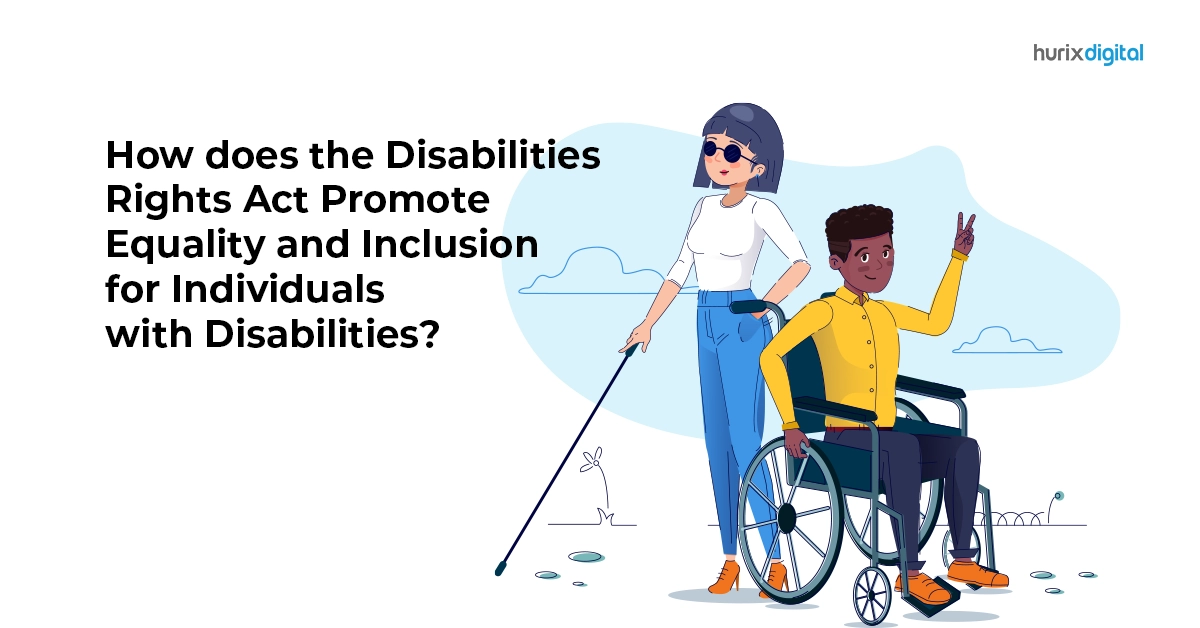
How Does the Disabilities Rights Act Promote Equality and Inclusion for Individuals with Disabilities?
Summarize with:
The world is becoming more inclusive by the day, and many businesses strive for inclusivity and equality. Hence, it becomes crucial to shed light on the challenges faced by individuals with disabilities and explore the legal frameworks designed to protect their rights.
Disability rights encompass a broad spectrum of legal protections, regulations, and initiatives to ensure equal opportunities and fair treatment for all. These rights are recognized and championed by various international and national bodies, all advocating for a more inclusive and accessible society. By exploring the fascinating landscape of disability rights, we aim to foster greater understanding, empathy, and support for individuals with disabilities.
In this blog post, we will provide an overview of disability rights and acts across various countries.
Table of Contents:
Types of Disability Rights and Acts
The nations realize that having a one-size-fits-all approach is not the right way to go. With over 16% of the world facing some form of disability, it became critical to recognize those, spread awareness, and make special provisions for them. There are various Disability Rights and Acts all around the world. Some of the key acts are:
1. The Rehabilitation Act of 1973
The Rehabilitation Act of 1973 was one of the first laws to prohibit discrimination against people with disabilities in programs and activities that receive federal funding.
The act includes several key provisions, including Section 504, which prohibits discrimination based on disability in any program or activity that receives federal funding. This section has been instrumental in promoting accessibility in areas such as education, healthcare, and transportation.
2. The Americans with Disabilities Act (ADA)
The Americans with Disabilities Act (ADA) was enacted in 1990 to provide a comprehensive civil rights act that protects individuals with disabilities. The ADA prohibits discrimination based on disability in areas such as employment, public accommodations, transportation, and telecommunications. The ADA also requires reasonable accommodations to be made for individuals with disabilities to ensure equal access to goods, services, and opportunities.
The ADA has had a significant impact on promoting accessibility and inclusion for people with disabilities. For example, the ADA has led to the installation of ramps, elevators, and other accessibility features in public buildings and transportation systems. The ADA has also led to increased employment opportunities for people with disabilities by requiring employers to provide reasonable accommodations to enable individuals with disabilities to perform their job duties.
The Developmentally Disabled Assistance and Bill of Rights Act is a US law providing federal funds to Councils on Developmental Disabilities, Protection, and Advocacy Systems, as well as University Centers.
3. The Equality Act 2010
The Equality Act 2010 is the primary legislation that protects individuals with disabilities in the United Kingdom. The act prohibits discrimination based on disability in areas such as employment, education, and the provision of goods and services. The act also requires employers to provide reasonable accommodations to employees with disabilities.
4. The RPWD Act, 2016
The Rights of Persons with Disabilities Act, 2016 is the disability legislation passed by the Indian Parliament to fulfill its obligation to the United Nations Convention on the Rights of Persons with Disabilities.
5. The Individuals with Disabilities Education Act (IDEA)
The Individuals with Disabilities Education Act (IDEA) is a federal law that ensures that children with disabilities receive a free, appropriate public education (FAPE). IDEA requires that schools provide special education and related services to eligible students with disabilities.
The law also requires that individualized education plans (IEPs) be developed for students with disabilities to ensure that their unique educational needs are met.
The IDEA has helped to promote inclusion and accessibility for children with disabilities by ensuring that they have access to educational opportunities and resources. The law has also helped to increase awareness of the educational needs of children with disabilities and the importance of providing appropriate support and accommodations.
6. The Assistive Technology Act (ATA)
The Assistive Technology Act (ATA) was enacted in 1998 to promote access to assistive technology devices and services for people with disabilities. The ATA provides funding to states to support programs that provide assistive technology devices and services to individuals with disabilities.
The ATA also supports the research and development of new assistive technology devices and services.
The ATA has helped to promote accessibility and independence for people with disabilities by increasing access to assistive technology devices and services. Assistive technology can include a wide range of devices and services, such as communication devices, mobility aids, and computer software. These devices and services can help people with disabilities communicate, navigate their environment, and perform daily tasks more independently.
7. Air Carrier Access Act (ACAA)
The Air Carrier Access Act (ACAA) is a federal law that prohibits discrimination against individuals with disabilities in air travel. The ACAA requires that airlines provide accommodations for individuals with disabilities, such as accessible seating, assistance with boarding and deplaning, and the transportation of mobility aids and other assistive devices.
The ACAA has helped to promote accessibility and inclusion for people with disabilities in air travel. The law has also helped to increase awareness of the needs of individuals with disabilities in the airline industry.
Also Read: AI & Accessibility: Is AI-Generated Content Bad for Accessibility?
How Do These Acts Promote Equality and Inclusion?
The purpose of these acts is quite simple – recognizing people with disabilities, and making the world, both offline and online, a space where they are equal to everyone. Here are some key ways in which the Disabilities Rights Act promotes equality and inclusion:
1. Accessibility
One of the fundamental principles of these acts is to ensure accessibility in public spaces and facilities. The law requires that reasonable accommodations be made to ensure individuals with disabilities have equal access to employment, public transportation, government services, schools, and places of public accommodation (such as restaurants, theaters, and hotels). This accessibility provision helps remove physical barriers and enables individuals with disabilities to fully participate in society.
2. Employment Opportunities
The act prohibits discrimination against qualified individuals with disabilities in all aspects of employment, including job application procedures, hiring, promotion, and termination. It requires employers to provide reasonable accommodations that enable individuals with disabilities to perform essential job functions unless it imposes an undue hardship on the employer. This provision ensures that individuals with disabilities have equal access to employment opportunities and are not unfairly excluded from the workforce.
3. Education
The act includes provisions that ensure equal access to education for individuals with disabilities. It requires schools, colleges, and universities to provide reasonable accommodations and modifications to enable students with disabilities to participate in educational programs and activities. Additionally, it prohibits discrimination against students with disabilities, ensuring that they are not denied admission or subjected to unequal treatment in educational settings.
Check out this exclusive Case Study: Hurix Digital Creates Accessible eBooks with Alt-text Descriptions for a Leading K-12 Publisher
4. Public Services and Transportation
The act mandates that state and local government entities provide equal access to public services and programs for individuals with disabilities. It includes accessible public transportation, such as buses and trains, as well as ensuring that government services, public facilities, and programs are accessible to all.
5. Communication Accessibility
The act recognizes the importance of effective communication for individuals with disabilities. It requires public entities, private businesses, and telecommunications companies to provide auxiliary aids and services, such as sign language interpreters or captioning. It ensures effective communication for people with hearing or speech disabilities. This provision helps bridge communication gaps and ensures that individuals with disabilities can fully engage in various interactions, including healthcare, legal proceedings, and public events.
Conclusion
Disability rights are a vital aspect of human rights, and many countries have enacted laws and policies to protect the rights of people with disabilities. These laws aim to ensure that people with disabilities have equal opportunities in all areas of life, including employment, education, and access to goods and services.
Individuals, businesses, and governments need to recognize and respect these rights and take steps to ensure that people with disabilities are not discriminated against or marginalized in society.
Hurix Digital is an organization that not only understands these acts but also helps businesses become more inclusive and accessible for all. You can connect with them to know how you can be a part of this accessible world.
Summarize with:

Vice President – Content Transformation at HurixDigital, based in Chennai. With nearly 20 years in digital content, he leads large-scale transformation and accessibility initiatives. A frequent presenter (e.g., London Book Fair 2025), Gokulnath drives AI-powered publishing solutions and inclusive content strategies for global clients
 We’re live! Explore the all-new
We’re live! Explore the all-new 




